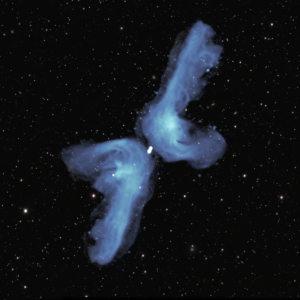An image from the VLA dramatically reveals the huge extent of the magnetic field of a spiral galaxy seen edge-on from Earth.


Wolfe Disk Press Release Video
In our 13.8 billion-year-old universe, most galaxies like our Milky Way form gradually, reaching their large mass relatively late. But a new discovery made with the [term]Atacama Large Millimeter/submillimeter Array (ALMA)[/term] of a massive rotating disk galaxy, seen when the universe was only ten percent of its current age, challenges the traditional models of galaxy formation.

Wolfe Disk Artist Impression
Artist impression of the Wolfe Disk, a massive rotating disk galaxy in the early, dusty universe. The galaxy was initially discovered when ALMA examined the light from a more distant quasar (top left).

Double Boomerang
This new image of galaxy PKS 2014-55, located 800 million light years from Earth, was made by NRAO scientist William Cotton with the South African Radio Astronomy Observatory (SARAO) MeerKAT telescope. It shows for the first time how the galaxy’s X-shape is actually a ‘double boomerang’. Two powerful jets of radio waves, indicated in blue color, originate from a massive black hole at the center of the galaxy. They each extend 2.5 million light years into space (comparable to the distance between the Milky Way and the Andromeda galaxy, our nearest major neighbour). Eventually, the jets are ‘turned back’ by the pressure of tenuous intergalactic gas. As they flow back towards the central galaxy, they are deflected by its relatively high gas pressure into the shorter, horizontal arms of the boomerang. The background image shows visible light from myriad galaxies in the distant universe.





